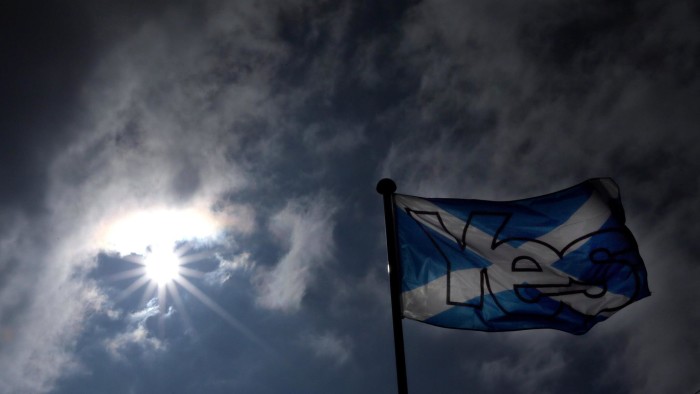Scots’ choice: independence or sterling

Roula Khalaf, Editor of the FT, selects her favourite stories in this weekly newsletter.
If Scotland votes Yes to independence the knee-jerk response in the markets is easy to predict: sell sterling, sell UK equities, sell Scottish financials and short Spanish debt on Catalonia fears. UK gilts may offer a safe haven but this is not certain given questions about the allocation of debt in divorce, enhanced risk of rump UK exit from the EU and potential contingent liabilities associated with a messy break-up of the UK.
In particular there has been insufficient attention to the challenge that would be faced by the Bank of England maintaining unlimited liquidity provision to Scottish banks during the transition to independence, particularly if uncertainty about future currency arrangements were to result in cross-border capital flight. There is a non-trivial risk this could end in a credit crunch in Scotland.
The onset of divorce negotiations would lay bare that Scotland faces an impossible trinity: full independence, financial stability and deep economic integration with the UK. It can have any two of these but not all three.
The declared objective of the pro-independence campaign is to unwind the British political and fiscal union while retaining a common currency. But the eurozone crisis demonstrated that monetary unions without deep integration are debt intolerant: they become unstable at relatively low levels of debt and deficits, particularly absent banking union.
Indeed, Scotland in a currency union would be like Spain or Portugal before the ECB’s “whatever-it-takes” commitment to save the euro: a minority partner in a central bank that could not be relied on to buy bonds to short-circuit any run on its debt, and so vulnerable to runs.
The Yes campaign would like Scotland to be like Spain or Portugal with a standing “whatever-it-takes” commitment to short-circuit any run on its debt. But eurozone countries are eligible for ECB support only if they agree to tough adjustment programmes; the BoE would have to impose similar conditionality on Scotland up front.
The question is whether Scotland could tolerate its fiscal policy being subject to tight constraints imposed by a BoE whose officials would be wholly or overwhelmingly appointed by the UK parliament.
As a fallback Scotland could adopt sterling unilaterally. But it would then be in a worse position than Spain or Portugal were during the eurozone crisis: it would have no control over the central bank that issues sterling and face still more elevated financial stability risk.
As Scots realise that the only way to combine full independence and financial stability would be for Scotland to sacrifice the current level of integration with the rest of the UK and adopt its own currency, Scottish banks could face erosion of deposits and wholesale funding. Big Scottish banks would announce their intention to relocate to London immediately, but small banks may not.
The BoE would presumably pre-empt bank runs by making it clear that Scottish banks retain access to its liquidity the morning after a Yes vote. But sustaining this position over time would be challenging. The BoE would risk building up sizeable exposures to entities that would become foreign banks in 2016. It might need a fiscal indemnity – but would the rest of the UK put its taxpayers on the line?
In depth

Scotland will decide in a referendum to be held on September 18 whether or not to end the 307-year-old union with England
Further reading
Moreover, even with a liquidity backstop for Scottish banks, Scottish deposits could still drain across the border if savers decided they wanted a future rump UK deposit guarantee or perceived any tail risk of forced redenomination. To the extent that the Bank of England provided replacement funding it would build up exposure to Scotland analogous to the ECB’s exposure to Greece and other periphery economies.
Scotland might try to negotiate a banking union between Scotland and rump UK and/or sufficient fiscal guarantees that could enable the Bank to continue to provide liquidity without limit. But this would be very hard to agree. If it were not forthcoming the Bank would have to manage down its exposure over time to the Scottish financial system, requiring lenders to find replacement sources of funding for Scottish assets. Banks that have shifted their headquarters to London might provide such funding but there are many unsettled issues, including how comfortable the Bank of England would be with them funding large “offshore” Scottish books of business from London. And if replacement funding were not fully available, the result would likely be a credit crunch for small and medium sized Scottish businesses.
The writer is vice-chair of ISI and a former member of the management committee of the New York Fed
Comments